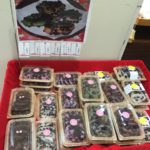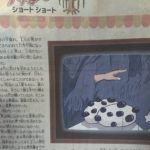フチャギ (or ふちゃぎ) fuchagi is a special Okinawa mochi; it is rice cake covered in azuki beans (小豆). This is a little different than muuchii. As I mentioned in other posts, beans are believed to ward off evil or demons. One of the main times of year to eat fuchagi is during Mid-Autumn Festival, around Autumn equinox and Tsukimi moon-viewing (occurs on the 15th of the 8th lunar month). They are also put on the altar and hinukan as an offering to give thanks for the current good harvest and to pray for future good harvests.
I was told the story behind the origin of fuchagi thanks to one of my older students. It is a kind of ghost story, really, but it has a happy ending.
Story of the origins of Fuchagi:
One day a man was kidnapped by a demon called a Majimun マジムン (a type of Ryukuan devil/monster) and entrapped in the tomb of an Aji 按司 (a type Ryukuan samurai, or feudal lord, high ranking person), located in a deserted area. He could not move and he could carely speak; only his hand could fit through a small opening to the outside of the tomb. He would cry for help in a husky voice, “Help me, help me…” but he received no replies.
After a few days, one night 2 men were walking near the tomb to take shelter from the rain. Suddenly, they noticed a hand emerge from the hole! They were terrified as they saw the human hand coming from the tomb, but they heard a husky voice pleading for help. The prisoner in the tomb told them his name and the village he was from, so the 2 men rescued him from the tomb, then bringing him back to his village via horseback.
However, 49 days had already passed since the man’s disappearance, so his family and the village held a funeral (one of the traditional number of days to hold a type of Buddhist funeral service), even without a body. Everyone was so surprised to see him approach as they were holding his funeral, but shed tears of joy at his return. The plain mochi used in the funeral was changed to celebratory mochi by adding beans to the surface (beans are used in celebrations and for warding off evil). Everyone ate the mochi covered in beans, and from then forward, fuchagi mochi is eaten to protect against evil every August 15th according to the lunar calendar.
Don’t live in Okinawa but want to make it at home? Here is the recipe at the bottom of this blog post (just scroll down); you can find all the ingredients pretty easily, but depending on where you live you may need to find an Asian market if these are not common in your regular grocery stores.




